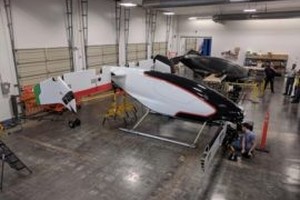
Airbus and its Silicon Valley-based innovation lab recently released a video of their Vahana personal transport during its first test flight, heralding the arrival of the first airborne taxis.

Vahana, which took to the air on January 31 at the Pendleton, Oregon, airport, was not the first such vehicle to fly. Chinese company eHang has been flying one for months, and has even made some short hops with people in the “pilot’s” seat, and Germany’s Volocopter famously flew the company’s CEO at the Consumer Electronics Show in January. But the participation of aerospace behemoth Airbus makes this test notable.
Vahana’s first flight is just the start of a hugely ambitious project. The first prototype will continue flight testing, soon to include transitioning into forward flight and demonstrating a sense-and-avoid system (critical for self-driving vehicles). A second prototype is concurrently experimenting with software and flight configurations.
First the good news: Vahana is one of the frontrunners among short-range, low-payload, vertical-takeoff-and-landing flying vehicles meant to provide quick trips across town. That’s a job often reserved for helicopters, which can fly much farther and carry much more weight than Vahana and its ilk, but given their operating costs, are all but reserved for wealthy people or for emergencies. Air taxis like Vahana would open short-range air transportation to a vast new market. The idea of zipping home above gridlocked highways, at a cost roughly the same as an ordinary taxi would charge for the same ride, is no longer science fiction.
On February 6 also EHANG announced that the EHANG 184 Autonomous Aerial Vehicle has achieved a series of manned flight tests carrying one and two passengers, including EHANG CEO and all executives, as well as many Guangzhou government officials.
But back to Vahana. It’s a prototype, and the history of transportation is full of great ideas that never reached production, and much-heralded inventions that, for one reason or another, never caught on (think Segways). There are plenty of issues standing between Vahana and success. At present, this relatively small type of personal transport is entirely reliant on batteries, since internal combustion engines would be too heavy and complex. Today’s batteries simply cannot store much energy: the recent 53-second flight, which reached an altitude of 16 feet, used up eight percent of the vehicle’s battery capacity.
“Until recently, electric propulsion has been too heavy to be practical,” says Zach Lovering, Vahana’s Project Executive. “Today, not only can we fly meaningful payloads at practical ranges using purely electric propulsion, but we can also do it at low cost.” The prototype has a range of about 30 miles, says Lovering, while the production version (expected in 2020) should have a range of around 65 miles (plus reserves), certainly long enough to make a few trips across town, but perhaps not enough for a practical air taxi; a 65-mile range limitation would be an existential nightmare to a ground-bound taxi company, and we have yet to see exactly how the circumstances will differ for their airborne counterparts.
Taking off and hovering are the most energy-intensive parts of Vahana’s flight regime, but other factors have to be considered, including how long the trip is, how much weight it’s carrying, and how much flying time the FAA requires as a safety margin (the agency hasn’t weighed in yet). Factor in the time it takes to recharge, expected battery lifetime, and other considerations, and power storage might become a critical issue. Another factor is noise. Although electric motors are significantly quieter than internal combustion engines, there is probably a good reason this new video substitutes music for ambient noise. The rotors themselves would be loud enough that it’s tough to envision one of these things landing in a quiet suburban neighborhood without protest from irritable neighbors.
Then there’s the fear factor: Commercial aviation is a century-old, accepted and extremely safe way to travel, yet many people are still terrified to fly. How cities will handle these vehicles taking off and landing over busy sidewalks and streets is an open question. (The Emirate of Dubai, to its credit, is eager to become a sort of real-world testing ground.) And how the FAA will regulate these vehicles and integrate them with the national airspace system are major unknowns. Vahana is an impressive, fascinating project. But the entire field of flying personal transport vehicles is still, in a manner of speaking, very much up in the air.
Quelle: Vavana
